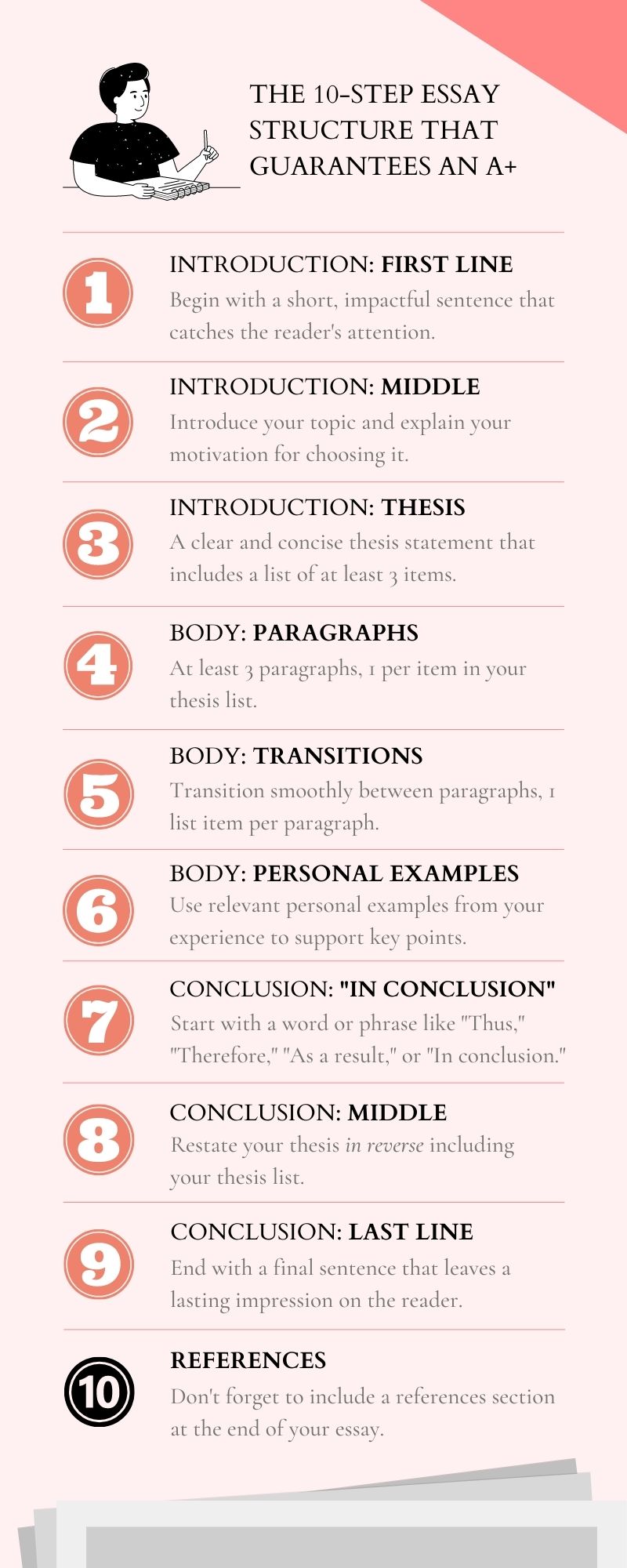Are you struggling with your essay structure? A well-structured essay can make all the difference in getting an A+. Here’s a 10-step essay structure that will help you get the grade you want. We even put it into an infographic for you!
Introduction:
- Begin with a short, impactful sentence that catches the reader’s attention. Example: “The past few decades have seen a growing focus on the study of gender and language.”
- The first paragraph is your introduction, where you should briefly introduce your topic and explain your motivation for choosing the topic. Example: “Over the past year, I’ve become aware of a gender bias at my school. Thus, I’ve set out to examine….”
- End with a clear and concise thesis statement that includes a list of at least 3 items. Example: “Through a close reading of chapter six, considering the elements of poetic technique, symbolism, and third-person narrative, I will show that Kate Chopin has foreshadowed the entire plot of The Awakening.”
Body:
- Include a minimum of three body paragraphs, one per item in your thesis list. Make sure to transition smoothly from one paragraph to the next.
- Use each point from the list in your thesis to structure each of your body paragraphs, making sure to transition smoothly from one paragraph to the next. For longer essays, each list item becomes a section. Example: Considering the Chopin thesis above, the writer should write a paragraph or section about how Chopin foreshadowed the plot using poetic technique, then one for how she used symbolism to foreshadow the plot, then one for how she used third-person narrative.
- Use personal examples to support key points, but make sure whenever you use a personal example, that it is truly relevant to the topic and that it demonstrates your depth of understanding.
Conclusion:
- Start your concluding paragraph using a word or phrase like “Thus,” “Therefore,” or “As a result.”
- Restate your thesis in reverse, including your thesis list. Example: “Therefore, through a close reading of chapter six, and considering the elements of poetic technique, symbolism, and third-person narrative, we can see that Kate Chopin has foreshadowed the entire plot of The Awakening.”
- End with a final sentence that leaves a lasting impression on the reader. Example: “Feminism will only go backwards if feminists do not find common-ground.”
References:
- Don’t forget to include a references section at the end of your essay.
Get the A+ You Deserve
By following these ten steps, you can develop an essay structure that not only helps you earn an A+ but also makes your writing process more efficient and enjoyable. Remember to start strong with an impactful sentence, provide background information in your introduction, and use a clear and concise thesis statement to guide your essay. When it comes to your body paragraphs, make sure to have a smooth transition between each paragraph and use personal examples to illustrate your points. Finally, wrap up your essay with a summary of your key points, a restatement of your thesis, and a memorable final sentence. With these tips, you can take your essay structure to the next level and create essays that impress your readers and earn you top marks.
What Is a Double Entendre?
A double entendre is a word or phrase with two meanings: one is obvious and literal, the other is more subtle, often humorous or risqué.
The Steampunk Genre: What is Steampunk and Why It Fascinates
The steampunk genre: What is steampunk, exactly, and why has it captured the imagination of so many readers and writers?
Oh Sugar! The Surprising Health Benefits of Swear Words
This article explores the unexpected advantages of swearing, and offers a list of 100 alternative swear words.
*This article was originally published on February 18, 2018 and was updated April 30, 2023.



